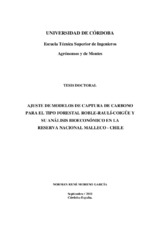Ajuste de modelos de captura de carbono para el tipo forestal Roble-Raulí-Coigüe y su análisis bioeconómico en la reserva nacional Malleco-Chile
Autor
Moreno García, Norman René
Director/es
Herrera Machuca, Miguel ÁngelCaraciolo Ferreira, Rinaldo Luiz
Ojeda Ojeda, Nelson Hernán
Editor
Universidad de Córdoba, Servicio de PublicacionesFecha
2012Materia
ChileCambio climático
Captura de carbono
METS:
Mostrar el registro METSPREMIS:
Mostrar el registro PREMISMetadatos
Mostrar el registro completo del ítemResumen
Los frecuentes fenómenos provocados por el cambio climático de orden global,
derivado del uso de combustibles fósiles y la eliminación de cubiertas vegetales, han
propiciado la negociación internacional de compromisos de reducción de emisiones y
otras medidas para mitigar el aumento del calentamiento global, principalmente por
parte de los países industrializados. Entre las alternativas de limitación, se ha propuesto
acreditar la captura y limitación de emisiones de carbono, uno de los principales Gases
Efecto Invernadero (GEI), en ecosistemas forestales.
En Chile existe una considerable superficie forestal, dividida en plantaciones exóticas y
una no menos importante superficie de bosques autóctonos. Son estos bosques
autóctonos los que hoy tienen una gran oportunidad de participar en el mercado de los
servicios ambientales como sumideros de carbono. Especializarse en técnicas de
gestión, su reglamentación, estimación de los turnos óptimos para la producción de
madera y captura de carbono, metodología para poder estimarlo y su posterior
valorización, permitirán la toma de decisiones para un desarrollo sustentable a nivel
nacional, regional y local.
Este trabajo presenta el ajuste de modelos para la captura de carbono y su análisis
bioeconómico para el Tipo Forestal Roble-Raulí-Coigüe en la Reserva Nacional
Malleco – Chile. Este tipo forestal actualmente se encuentra susceptible de ser
manejado con fines productivos y ambientales debido a la reciente aprobación en el año
2008 de la Ley 20.282 de Recuperación del Bosque Nativo y Fomento Forestal.
Los modelos que mejor se ajustaron fueron C = eb0 dapb1 hb2 y C = b0 + b1 (dap2 h),
donde C es el contenido de carbono (TonC/ ha), la variable dap es el diámetro a la altura
del pecho y h es altura. Sus coeficientes de determinación ajustado fueron para dap < a
80 cm 0,94 y 0,94 respectivamente y para dap > a 80 cm sus coeficientes fueron 0,99 y
0,98.
Luego de la determinación de la capacidad de captura de carbono para este tipo forestal,
se determinaron sus edades de rotación con respecto a la producción de madera que fue
a los 46 años y si consideramos la captura de carbono y conservación de la diversidad
más las bonificaciones contempladas en a legislación chilena para manejo de bosques
autóctonos, los turnos óptimos quedan determinados a los 49 y 52 años
respectivamente. Frequent events arising from global climate change, a cause of using fossil fuels and
removing forest cover, have motivated the negotiation of international agreements to
reduce emissions and other measures to mitigate the growth of global warming, mostly
from industrialized countries. Among the alternatives of limitation, it has been proposed
to credit the offset and limitation of carbon, a main greenhouse gas (GHG) in forest
ecosystems.
Chile presents a considerable forest area, made of fast-growing exotic plantations and
an important area of native forests. This context would allow for development of
environmental projects related to forests, and specialization in management and
techniques of environmental services, know about their regulations, economic benefits,
distribution, how to add value and eventual increase in economic value, as well as
recognize the factors that intervene in strengthening these initiatives as new alternatives
to the management of forests.
This work presents the model adjustment for the capture of carbon and his analysis
bioeconómico for the Forest Type Roble-Raulí-Coigüe in the National Reservation
Malleco - Chile. This forest type nowadays is capable of there being handled by
productive and environmental ends due to the recent approval in the year 2008 of the
Law 20.282 of Recovery of the Native Forest and Forest Promotion.
The models who better adjusted were C = eb0 dapb1 hb2 and C = b0 + b1 (dap2 h), Where
C is the content of carbon (TonC/has), the variable dap is the diameter at a height of the
chest and h is a height. His coefficients of determination fitted went for dap <to 80 cm
0,94 and 0,94 respectively and for dap> to 80 cm his coefficients were 0,99 and 0,98.
After the determination of the capacity of capture of carbon for this forest type, his ages
of rotation decided with regard to the production of wood that was at the age of 46 and
if we consider more bonuses to be the capture of carbon and conservation of the
diversity contemplated in to Chilean legislation for managing of autochthonous forests,
the ideal shifts remain certain at the age of 49 and 52 respectively.

